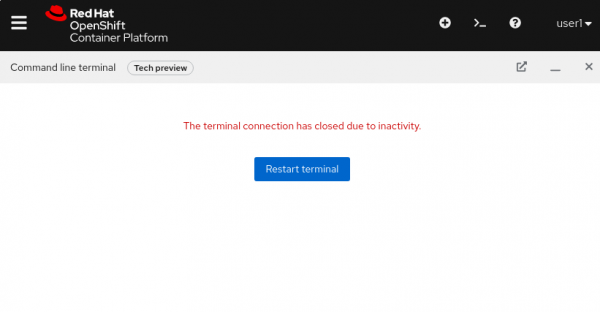Red Hat OpenShift's Web Terminal Operator is a way for users to access a web terminal with common cluster tooling pre-installed. This gives you the power and flexibility to work with your product directly through the OpenShift web console, eliminating the need to have all your tooling installed locally.
This article is an overview of the new features introduced in Web Terminal Operator 1.2. These improvements include allowing cluster administrators to securely access the terminal, more information for users when a terminal has shut down due to inactivity, and a tooling update to align with OpenShift 4.7.
Easier access to the OpenShift web console
In Web Terminal Operator 1.2, cluster administrators can access the web terminal directly, as shown in Figure 1.

Now, everyone on your cluster can access their own web terminal, regardless of their permission level. Note that for security reasons, cluster administrators will automatically bypass the namespace picker and have their web terminal created in the openshift-terminal namespace. Other than that, the functionality remains the same as that of a user without the cluster-admin role.
Understanding why a terminal has stopped
To conserve resources, the web terminal automatically shuts down after 15 minutes of inactivity. In Web Terminal Operator 1.2, we’ve added more information to help users understand why a terminal has stopped (see Figure 2).

Web Terminal Operator 1.2 also offers an easier way to restart the terminal with the click of a button, as shown in Figure 3.

Updated tooling
We have updated the default binaries in Web Terminal Operator 1.2 to include the latest versions of the built-in command-line tools, as shown in Table 1.
| Binary | Old version | New version |
|---|---|---|
oc |
4.6.1 | 4.7.0 |
kubectl |
1.19.0 | 1.20.1 |
odo |
2.0.0 | 2.0.4 |
helm |
3.3.4 | 3.5.0 |
kn</code |
0.16.1 | 0.19.1 |
tkn |
0.11.0 | 0.15.0 |
Additional resources
For a peek into how the Web Terminal Operator works under the hood, see A deeper look at the Web Terminal Operator by Angel Misevski. You can also check out the initial release article by Joshua Wood: Command-line cluster management with Red Hat OpenShift’s new web terminal.
Last updated: March 5, 2021